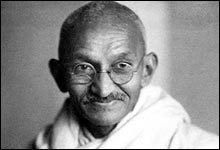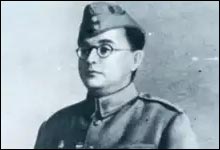GREAT INDIAN PERSONALITIES : Jatindra Nath Mukherjee - Bagha Jatin

Jatindra Nath Mukherjee was born in Jhenaidha district of Bengal in 1879. It is said that he came to be called 'Bagha Jatin' after killing a tiger single-handed and without any arms. Jatin's mother, a widow, raised him to be self-confident and to fight for those who could not fight for themselves. After passing the Entrance Examination he was appointed a stenographer to the government of Bengal and proved his efficiency as a sincere, honest, obedient and diligent employee.
Jatin, a man with a strong sense of self-respect and national pride, came in contact with Aurobindo Ghosh and his Anushilan Samiti. He took part in climbing, swimming, shooting and in the body building Akhda or Anushilan Samiti of the revolutionary organisation Yugantar. There he met Naren (Manabendra Nath Roy) and the two soon gained the confidence of one another. In 1908 Jatin, with some revolutionaries, was implicated in the Alipore Conspiracy Case. In the judgement Anushilan Samiti was declared illegal and banned. Jatin and Naren, acquitted for want of evidence, went in hiding to Howra-Shibpur area and continued underground works with other revolutionaries.
Jatin was once again arrested in the Howra-Shibpur Conspiracy Case, and those who were arrested with him were given the common name 'Jatin's gang'. They were so ruthlessly tortured that some of them died and some lost their mind. Jatin, though acquitted in this case also for want of evidence, was dismissed from service. When in jail, Jatin and Naren made a long term programme to capture power from British through armed insurrection. They planned to unite different groups of patriots.
With this intention Naren traveled extensively all over India as a Sanyasi and organised the revolutionaries in Bengal and elsewhere. The leaders of various groups gathered together on the occasion of relief works during the floods in Hughli and Midnapore. They chose Jatin Mukherjee and Rashbehari Bose as leaders for Bengal and northern India respectively.

Attempts were made to organise the Indian revolutionaries outside India also. A Yugantar Ashram was formed at San Francisco and the Shikh community took active part in the struggle for freedom. With the outbreak of the First World War, the Indian revolutionaries of Europe gathered together in Berlin to form the Indian Independence Party and sought German assistance, to which the German government agreed. The Indian Independence Party sent an emissary to Jatin Mukherjee to negotiate with the German Consul General in Calcutta. In the meantime Jatin was made the Commander-in-Chief of the entire revolutionary forces. Naren, leaving Jatin in hiding in Baleswar (Orissa), went to Batavia to negotiate a deal with German authorities there for the shipment of arms and financial help.
Police, however, discovered the hideout of Jatin in a paddy field in Buribalam. On 9th September 1915, after heavy exchange of fire Jatin was found dead.


